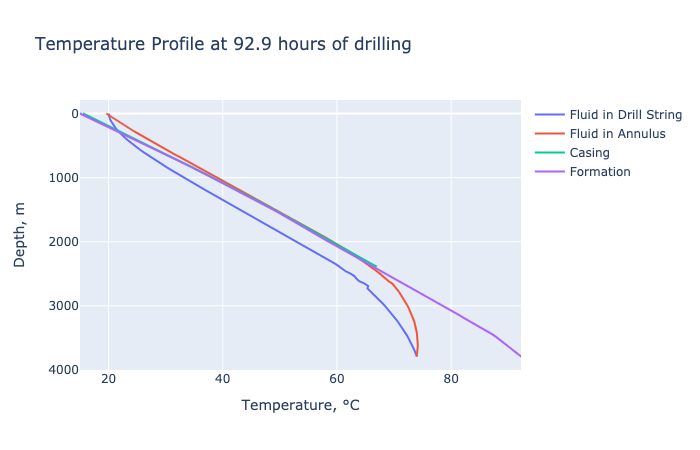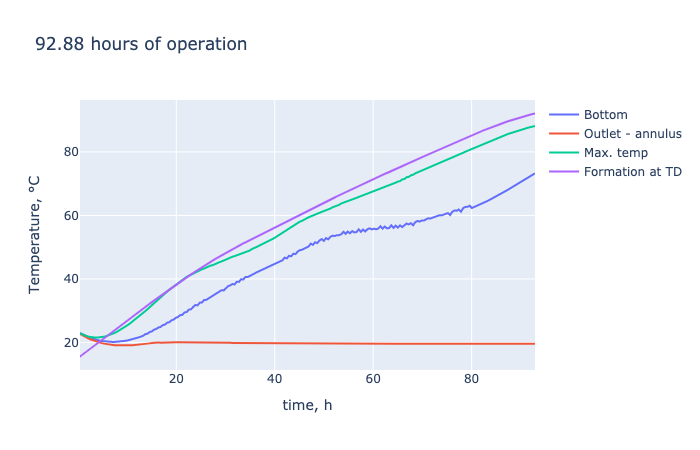
Temperature during Drilling¶
-
pwptemp.calc_temp(trajectory, casings=None, set_inputs=None, operation='drilling', time_steps=210, smooth=True, cells_no=None)[source]¶ Function to calculate the well temperature distribution during a specific operation at a certain time.
- Parameters
trajectory – wellbore trajectory excel|csv|dataframe|list
casings – list of dictionaries with casings characteristics (od, id and depth)
set_inputs – dictionary with parameters to set.
operation – define operation type. (‘drilling’, ‘circulating’)
time_steps – number of time steps to run calculations.
smooth – smooth the temperature profiles.
cells_no – (int) number of cells. If None -> keep same number of cells than trajectory
- Returns
Well temperature distribution object
-
pwptemp.temperature_behavior(well)[source]¶ Function to simulate the temperature behavior.
- Parameters
well (obj) – well temperature distribution object
- Returns
temperature behavior object
Example¶
>>> import pwptemp as pt
>>> import well_profile as wp
>>> trajectory = wp.load('trajectory1.xlsx', equidistant=True) # using well_profile to load a trajectory
>>> casings = [{'od': 12, 'id': 11, 'depth': 1200}, # creating 3 casings with respective parameters
>>> {'od': 10, 'id': 9, 'depth': 1500}, # diameter [in] and depth [m]
>>> {'od': 8, 'id': 7, 'depth': 2400}]
>>> rop_list = [50, 45, 40, 35] # setting respective ROP [m/h] for each section
>>> well = pt.calc_temp(trajectory, # calculate the well temperature distribution using pwptemp
>>> casings,
>>> set_inputs={'water_depth': 0, 'temp_inlet': 20, 'rop':rop_list,
>>> operation='drilling',}
>>> pt.plot_distribution(well).show()
Notice!
The total time of drilling is calculated based on the ROP’s set for the sections. The simulation assumes a break after each section is drilled (here is when casing is run and cemented) so the temperature becomes stable again. i.e. for this particular case, it takes 92.9 hours only drilling the whole wellbore.
The table below shows the available inputs that can be set when using the parameter set_inputs
Name |
Units |
|---|---|
temp_inlet |
°C |
temp_surface |
°C |
water_depth |
in |
pipe_id |
in |
pipe_od |
in |
riser_id |
in |
riser_od |
in |
fm_diam |
in |
flowrate |
m3/min |
Thermal Conductivities————- |
|
tc_fluid |
W / (m °C) |
tc_csg |
W / (m °C) |
tc_cem |
W / (m °C) |
tc_pipe |
W / (m °C) |
tc_fm |
W / (m °C) |
tc_riser |
W / (m °C) |
tc_seawater |
W / (m °C) |
Specific Heat Capacities———– |
|
shc_fluid |
J / (kg °C) |
shc_csg |
J / (kg °C) |
shc_cem |
J / (kg °C) |
shc_pipe |
J / (kg °C) |
shc_riser |
J / (kg °C) |
shc_seawater |
J / (kg °C) |
shc_fm |
J / (kg °C) |
Densities————————– |
|
rho_fluid |
sg |
rho_pipe |
sg |
rho_csg |
sg |
rho_riser |
sg |
rho_fm |
sg |
rho_seawater |
sg |
rho_cem |
sg |
Others—————————– |
|
th_grad_fm |
°C/m |
th_grad_seawater |
°C/m |
hole_diam |
m |
rpm |
rev. per min. |
tbit |
kN*m |
wob |
kN |
rop |
m/h |
an |
in^2 |
bit_n |
0 to 1 |
dp_e |
0 to 1 |
thao_o |
Pa |
beta |
Pa |
alpha |
1/°C |
k |
Pa*s^n |
n |
dimensionless |
visc |
cP |
Web Application¶
There is also the web-app based on pwptemp:

